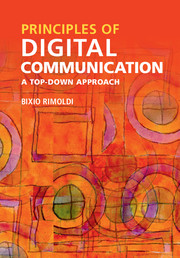Book contents
- Frontmatter
- Dedication
- Contents
- Preface
- Acknowledgments
- List of symbols
- List of abbreviations
- 1 Introduction and objectives
- 2 Receiver design for discrete-time observations: First layer
- 3 Receiver design for the continuous-time AWGN channel: Second layer
- 4 Signal design trade-offs
- 5 Symbol-by-symbol on a pulse train: Second layer revisited
- 6 Convolutional coding and Viterbi decoding: First layer revisited
- 7 Passband communication via up/down conversion: Third layer
- Reference
- Index
1 - Introduction and objectives
Published online by Cambridge University Press: 05 January 2016
- Frontmatter
- Dedication
- Contents
- Preface
- Acknowledgments
- List of symbols
- List of abbreviations
- 1 Introduction and objectives
- 2 Receiver design for discrete-time observations: First layer
- 3 Receiver design for the continuous-time AWGN channel: Second layer
- 4 Signal design trade-offs
- 5 Symbol-by-symbol on a pulse train: Second layer revisited
- 6 Convolutional coding and Viterbi decoding: First layer revisited
- 7 Passband communication via up/down conversion: Third layer
- Reference
- Index
Summary
This book focuses on the system-level engineering aspects of digital point-to-point communication. In a way, digital point-to-point communication is the building block we use to construct complex communication systems including the Internet, cellular networks, satellite communication systems, etc. The purpose of this chapter is to provide contextual information. Specifically, we do the following.
(i) Place digital point-to-point communication into the bigger picture. We do so in Section 1.1 where we discuss the Open System Interconnection (OSI) layering model.
(ii) Provide some historical context (Section 1.2).
(iii) Give a preview for the rest of the book (Section 1.3).
(iv) Clarify the difference between analog and digital communication (Section 1.4).
(v) Justify some of the choices we make about notation (Section 1.5).
(vi) Mention a few amusing and instructive anecdotes related to the history of communication (Section 1.6).
(vii) Suggest supplementary reading material (Section 1.7).
The reader eager to get started can skip this chapter without losing anything essential to understand the rest of the text.
The big picture through the OSI layering model
When we communicate using electronic devices, we produce streams of bits that typically go through various networks and are processed by devices from a variety of manufacturers. The system is very complex and there are a number of things that can go wrong. It is amazing that we can communicate as easily and reliably as we do. This could hardly be possible without layering and standardization. The Open System Interconnection (OSI) layering model of Figure 1.1 describes a framework for the definition of data-flow protocols. In this section we use the OSI model to convey the basic idea of how modern communication networks deal with the key challenges, notably routing, flow control, reliability, privacy, and authenticity. For the sake of concreteness, let us take e-mailing as a sample activity. Computers use bytes (8 bits) or multiples thereof to represent letters. So the content of an e-mail is represented by a stream of bytes. Received e-mails usually sit on a remote server. When we launch a program to read e-mail – hereafter referred to as the client – it checks into the server to see if there are new e-mails. It depends on the client's setting whether a new e-mail is automatically downloaded to the client or just a snippet is automatically downloaded until the rest is explicitly requested. The client tells the server what to do.
- Type
- Chapter
- Information
- Principles of Digital CommunicationA Top-Down Approach, pp. 1 - 22Publisher: Cambridge University PressPrint publication year: 2016



